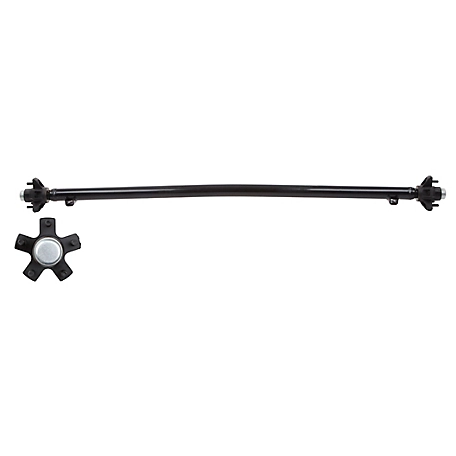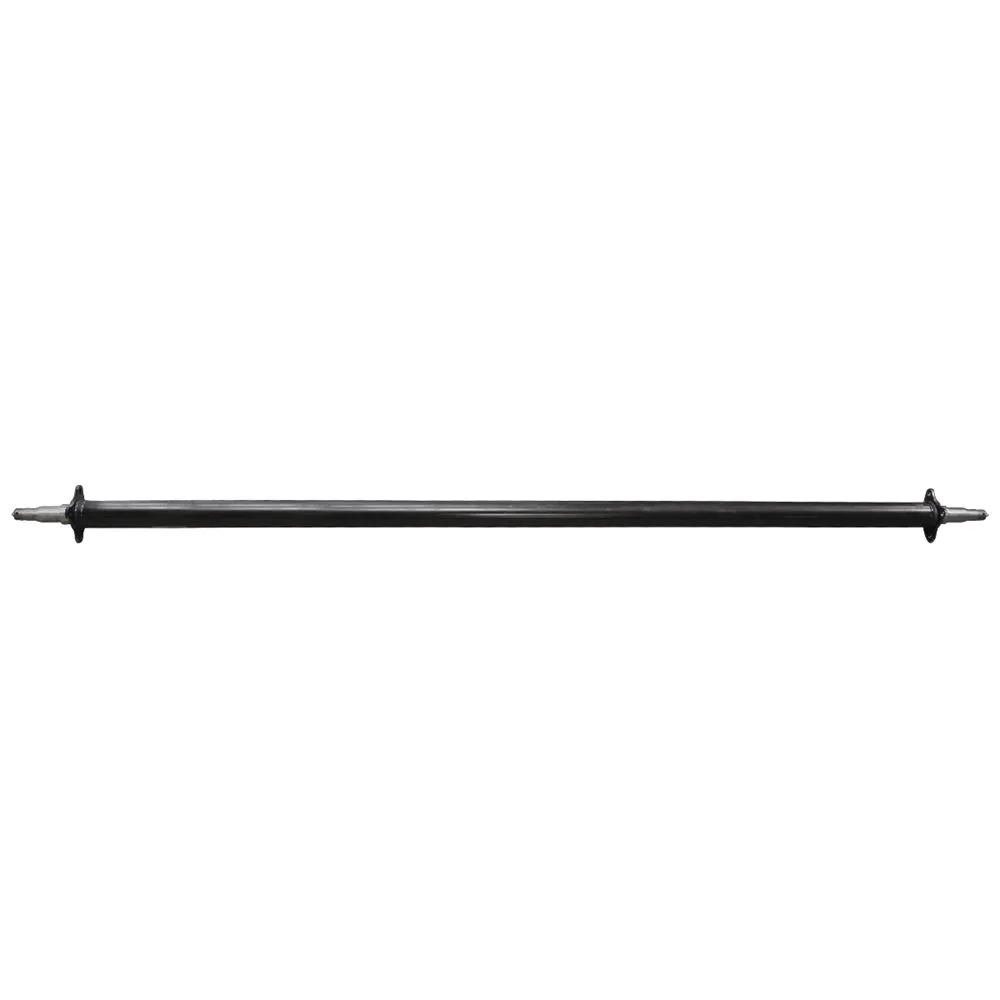Product Description
About torsion axle
Torsion axles offer a low-maintenance, reliable, quiet, smooth ride. Mastervim torsion axles make it simple to have peace of mind while trailer towing.
Torsion axles have taken the trailer industry by storm in recent years. The boom in usage can be attributed to the many benefits that torsion axles offer over standard spring axles. Their innovative design provides an array of benefits and avoids many of the shortfalls that have commonly been found in traditional spring axles.
Torsion Axle Benefits
No Maintenance
Torsion axles have a very simple design, using rubber cords and an inner bar, rather than the large array of parts found in a spring axle. The simplicity of this design means that there is little to no maintenance that needs to be done. All you have to do is lube your wheel bearings.
Smooth, Quiet Ride
Torsion axles function using a simple design that utilizes the compression of rubber cords inside the axle to cushion the trailer. This twisting and compression motion is very smooth and it rides nicely even when there is no load. Furthermore, there is no metal-to-metal contact inside the axle making it quieter and less abrasive.
Reliable
Torsion axles have fewer moving parts than traditional forms of trailer suspension. As mentioned earlier, there is no metal-to-metal contact within the axles components. This means that there are no CZPT parts rubbing against each other, causing wear or corrosion. Likewise, the rubber construction means that the axles are more corrosion resistant.
Versatility
Torsion axles can be used in an extensive range of applications, due to the ease of adjustment. To change the height of a torsion axle, the torsion bars just need to be adjusted. Additionally, half-torsion units can be used, meaning that the application does not need an axle that passes under the entire trailer. This opens up the opportunity for many custom applications and can provide benefits such as additional ground clearance.
When is it better than a Spring Axle?
They are particularly advantageous over springs axles for applications like:
- Marine/Boat trailers
- Rough/bumpy surfaces
- When much lower or higher ride height is needed
- High vibration applications (like wood chippers or generators)
- Custom applications
- Applications with limited mounting space
- Corrosive environments (like saltwater)
Torsion Axles can improve your trailer-towing experience.
Application
Camper trailer, Fifth-wheel trailer, Off-road trailer, Toy hauler trailer, Double-decker trailer, Caravan towed trailer, Solar trailer, Horse trailer, Jeep trailer, Lowboy trailer, Mobile Home, Pup up trailer, Dolly trailer, Tow dolly, Car hauler, Construction trailer, Genset trailer, Generator trailer, Snowmobile trailer, Boat trailer, Aluminum trailer, Utility trailer, Light duty trailer, etc.
Other products
Rubber Torsion Axle without brake
Rubber Torsion Axle with Electric drum brake
Rubber Torsion Axle with Mechanical drum brake
Rubber Torsion Axle with Mechanical Disc brake
Rubber Torsion Axle with Hydraulic drum brake
Rubber Torsion Axle with Hydraulic Disc brak
Related Product
Capacity Range
450kg/750kg/1000kg/1250kg/1500kg/1750kg/2000kgs/2500kg/3000kgs/3500kg/4000kg
1,650lb/1,750lb/2,500lb/3,500lb/5,200lb/6,000lb/7,000lb /8,000lb
Product Process
Cutting axle tube>welding bracket>welding torsion arm with torsion bar>surface treatment>press rubber
Why choose Mastervim?
Mastervim was established in 2004, as a manufacturer of products for trailers. The product range has varied greatly during our evolution, currently, Mastervim is focusing on developing axles, suspensions, brake parts and other components for the trailer industry.
Our customers represent all types of trailer manufacturers including marine, RV, horse, commercial/industrial, cargo, etc.
Over the past several years, Mastervim has built 5 plants in China, designed several production lines of fully customed parts, involving casting, forging, machining, welding, painting and assembling.
Mastervim is grateful to our OEM customers and suppliers for their trust and support. Please bring your suggestions for improvement to us in our efforts to make a better company. We look forward to serving you in the future.
- Instant Response: 7 x 24 hours online, reply within 3 hours
- Quick Shipping: Big 3 broker partner -MSC COSCO shipping lines, familiar with America AU EU
- OEM Advantages: Unique R&D capability/3D printer Virtua modeling/20 years experience
- Quality Control: Word famous QC system/TUV SGS DOT/Quality guarantee
| After-sales Service: | Yes |
|---|---|
| Warranty: | 24 Month |
| Type: | Axle |
| Certification: | ISO/TS16949, CCC, DOT, ISO, CE |
| Loading Weight: | 3500 Lb |
| ABS: | Without ABS |
| Samples: |
US$ 250/Piece
1 Piece(Min.Order) | |
|---|
| Customization: |
Available
| Customized Request |
|---|

What are the legal regulations or guidelines regarding trailer axle weight limits?
Trailer axle weight limits are subject to legal regulations that vary by region and are designed to ensure road safety and preserve infrastructure. Here are some common guidelines:
- Maximum Weight Limits: Most regions specify the maximum allowable weight on a single axle, tandem axles, or multi-axle configurations.
- Gross Vehicle Weight Rating (GVWR): Trailers are assigned a GVWR, indicating the maximum weight they can legally carry, including cargo and the trailer’s own weight.
- Per-Axle Weight Limits: Legal limits restrict the weight any single axle or axle group can carry. These limits can vary by axle spacing.
- Weight Distribution: Regulations often require proper weight distribution between axles to prevent overloading a particular axle.
- Permits for Oversized Loads: Transporting loads exceeding standard weight limits may require special permits and adherence to specific regulations.
- Axle Spacings: Legal restrictions may govern the distance between axles or axle groups, affecting weight distribution.
- Tire Load Ratings: Trailer tires must meet or exceed the expected load, and tire ratings impact weight limits.
- State and Local Regulations: In the United States, weight limits can vary by state and locality, so it’s important to be aware of and comply with local laws.
It’s crucial for trailer owners and operators to understand and adhere to these regulations to ensure safe and legal operation. Non-compliance can result in fines, road safety hazards, and damage to roads and bridges.

What are the key considerations when selecting the right trailer axle for a specific application?
Choosing the appropriate trailer axle for a specific application involves several critical considerations:
- Weight Capacity: Determine the maximum weight the axle will need to support. This includes the trailer’s payload and the weight of the trailer itself. Ensure the selected axle has a weight capacity that exceeds the application’s requirements to provide a safety margin.
- Axle Type: Select the axle type based on the application. Common types include straight axles, drop axles, and torsion axles. The choice depends on factors like ground clearance, load height, and suspension design.
- Axle Configuration: Decide on the number of axles needed. Single axles are suitable for lighter loads, while tandem and tri-axle configurations offer higher weight capacities. Multi-axle setups provide better weight distribution.
- Suspension Type: Choose the appropriate suspension system, such as leaf spring, air ride, or torsion suspension. The suspension affects ride quality, load stability, and maintenance requirements.
- Brake System: Consider the braking requirements. Larger and heavier trailers often require electric or hydraulic brakes. Ensure the axle accommodates the necessary brake system, including the brake size and type.
- Axle Material: Select the axle material, typically steel or aluminum. Steel axles are durable and cost-effective, while aluminum axles are lighter and corrosion-resistant. The choice depends on the application’s demands and budget.
- Hub and Spindle Type: Choose hubs and spindles compatible with the axle. The hub style affects the type of wheel and tire you can use, while spindle size impacts weight capacity and bearing compatibility.
- Wheel Bolt Pattern: Ensure the axle’s hub and wheel bolt patterns match to avoid compatibility issues with the wheels and tires you plan to use.
- Ground Clearance: Consider the required ground clearance for the application. Lower ground clearance may be suitable for highway travel, while off-road or specialty trailers may need increased clearance.
- Legal Compliance: Ensure that the selected axle and trailer configuration comply with local and national regulations regarding weight limits, axle spacing, and safety requirements.
- Manufacturer and Warranty: Choose a reputable axle manufacturer with a track record for quality and durability. Check the warranty and support offered by the manufacturer.
- Budget: Evaluate the budget constraints for the axle and select an option that balances cost-effectiveness with meeting the application’s needs.
By carefully considering these factors, you can select the right trailer axle that ensures safe and efficient performance for your specific application.

How does the placement of trailer axles affect weight distribution and towing?
The placement of trailer axles plays a crucial role in weight distribution and towing characteristics. There are two primary axle configurations: single axle and tandem axle, each with distinct effects:
1. Single Axle Trailers:
– Single axle trailers have only one axle positioned toward the rear of the trailer. This configuration is common in smaller utility and light-duty trailers.
– Weight Distribution: With a single axle, more of the trailer’s weight is concentrated toward the rear. This can lead to inadequate weight distribution and make the trailer prone to swaying or fishtailing during towing.
– Towing Characteristics: Single axle trailers are generally easier to maneuver and tow, making them suitable for smaller loads and shorter trips. However, they may lack stability with heavier loads.
2. Tandem Axle Trailers:
– Tandem axle trailers feature two axles placed closer together, typically with one in front of the other. This design is commonly found in larger trailers and offers several advantages.
– Weight Distribution: Tandem axles distribute the trailer’s weight more evenly. This improves stability and reduces the risk of swaying. The weight is better balanced between the axles, leading to improved control during towing.
– Towing Characteristics: Tandem axle trailers are more stable and capable of handling heavier loads. They are less prone to sway, making them suitable for long-distance hauling and larger cargo.
– Additional Features: Tandem axle trailers may have braking systems, which further enhance safety and control during towing, especially when towing heavier loads.
– Considerations: It’s important to note that the placement of axles within a trailer also affects the tongue weight (the downward force on the hitch). Proper tongue weight is essential for safe towing, and it can be adjusted by positioning the cargo within the trailer.
– Ultimately, the choice between single and tandem axles depends on the trailer’s intended use and the weight of the cargo. Tandem axle trailers are preferred for heavier loads and long-distance towing, while single axle trailers are suitable for smaller, lighter loads and shorter trips. Proper weight distribution and adherence to safety guidelines are critical for safe and stable towing.


editor by CX 2023-12-07